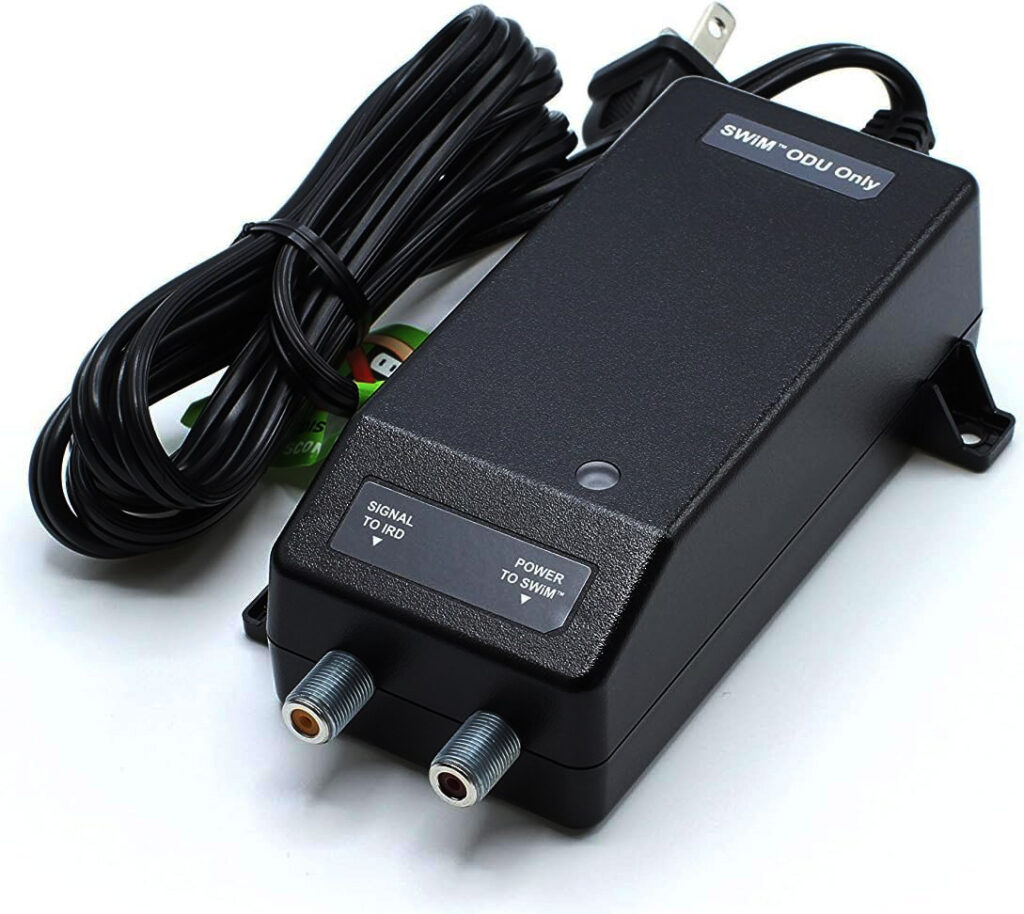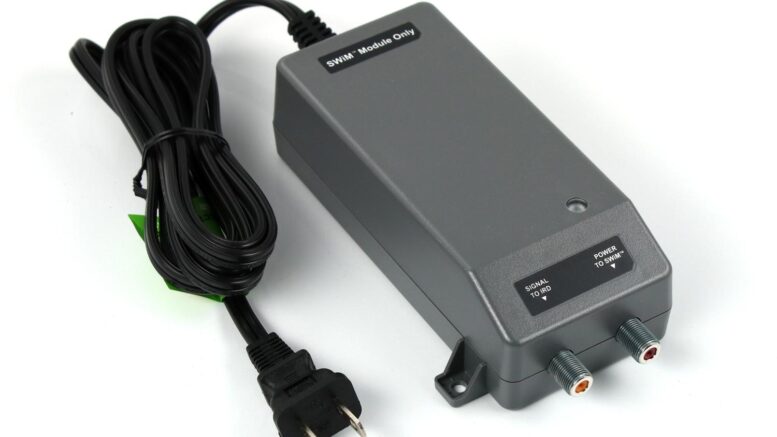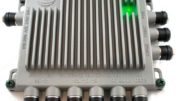What you see above you is DIRECTV’s standard power inserter. It’s little changed from the version that debuted with the SWM-5 in 2007. It’s not a terribly high tech piece of equipment; it’s really just a power supply with an internal splitter in it to let you pass signal through if you want to. This device supplies 29 volts at a maximum of 1.5 amps. It’s hardly mysterious.
It’s also the only power inserter I personally recommend for any DIRECTV equipment. However, two things have recently been brought to my attention, and that’s made me want to explain my position a bit when it comes to this device. Specifically, when it comes to this device compared to this other one:

This is DIRECTV’s PI-21 power inserter. The big thing you’ll notice is that it’s black instead of gray. It supplies 21 volts at a maximum of 1.2 amps, and as a result it’s not able to power something like a SWM-30 multiswitch. But, as I said there are two points that bear discussion:
- DIRECTV technicians are still putting the PI-21 in homes today, right now.
- The Genie 2 and HR54 are both perfectly capable of powering a satellite dish, and they both supply 21 volts at a maximum of 1.2 amps.
So, given that information, why do I tell people not to use the PI-21 at all? Why does Solid Signal not even sell it? Here’s the explanation.
Why voltage is important
A DIRECTV dish, even a SWM-enabled dish, only needs 12 volts to function. So why is it so important that we send it so much more voltage than that? In order to understand the answer, you have to understand how that excess voltage is used.
DIRECTV dishes internally have the ability to look at six different types of signal. Four of those signal types have been in use since the mid-2000s, when everything needed to be a lot simpler. In order for the system to know which of those four is being sent to it, a combination of voltage and a special “tone” signal are used.
If odd transponders are needed, the cable heading back down carries 18 volts. If evens are needed, the cable only carries 13 volts. For the satellites at 99 and 101, that’s the whole story. For the satellite at 103, there’s also a signal put on the line at 22kHz to help the receiver or multiswitch understand what it’s getting.
Those other two signals
Very briefly, those other two signals belong to the broadcasts from DIRECTV’s “reverse band” frequencies. They’ve only been in use since the mid-2010s. DIRECTV multiswitches got a lot better over time at understanding frequencies so those signals don’t need to show a difference in voltage in order to distinguish themselves. So I’m not going to discuss them other than that.
What’s going on inside the dish
When you have a SWM-enabled dish, it’s doing a lot. There’s a huge amount of stuff happening at all times. First of all, it’s receiving all the signals from all three of DIRECTV’s satellite locations. Then, it’s “downconverting” those signals to frequencies that can travel over coax cable. Finally, a low-noise amplifier is used to pump up the signals so that they can travel down to your receivers. You might have heard the term “LNB” which is usually used to describe the front part of the dish. That term stands for “low noise amplifier and block downconverter.”
All that work, surprisingly, takes very little power to accomplish. In truth, 21 volts at 1.2 amps is more than sufficient. You could probably use quite a bit less voltage and still have it work, because today’s LNBs are much more efficient than the original SWM-enabled LNBs. But to keep things consistent, DIRECTV stays with the higher voltage.
When you have an external multiswitch
When you are using a Legacy LNB, there’s a lot more going on. You’re running multiple cables to an external multiswitch. That multiswitch is then distributing the signal. External multiswitches require more voltage to run, because they are not only doing their own work but supplying voltage to the dish as well. For that reason, an external SWM multiswitch requires a minimum of 24 volts at a maximum draw of 1.5 amps. 29 volts is preferred unless the power adapter is very close to the multiswitch.
It’s critical that the multiswitch send enough power to the dish in order for it to function properly. While the dish itself only requires 12 volts, it needs to be able to send 18 volts back down the line so that the multiswitch knows which signal it is receiving. Specifically, the multiswitch assumes that any voltage over 16 is an 18 volt signal, while any voltage under 16 is a 13 volt signal. So if the dish isn’t receiving enough power to send 16 volts back down, the multiswitch won’t work right.
Considering voltage loss over cable
According to spec, RG6 cable loses .06 volts per foot. That’s a lot of loss compared to something like Romex which loses about .007 volts per foot with the same current. This is the reason that we say the power inserter should be no more than 50 cable-feet from the dish. At 50 feet, you have lost 3 volts, meaning that with a 21 volt power inserter you’re only supplying 18 volts to the dish. That’s perilously close to the minimum voltage you can supply without problems.
This is why I always recommend a 29 volt power inserter. If you’re supplying power to a multiswitch, you can have a cable run of well over 100 feet before things get really critical. In cases where you’re powering a commercial dish using a PLPI power inserter, you may need that extra cable run in order to get from an intermediate closet to the dish itself.
Is it a problem using one power inserter or the other?
The DIRECTV dishes are perfectly capable of taking anything from 20-30 volts without any damage. The net result of using a higher-voltage power inserter is that it draws fewer amps and the net wattage is the same with either power inserter. So, there’s no downside to using the grey, 29 volt power inserter 100% of the time.
While I don’t personally like using the black power inserter, if it works then it works. There’s no reason to change your power inserter if it’s working for you, unless you would like the freedom to move the power inserter later. If you have a black power inserter and it’s 10 years old or older, it’s not a bad idea to replace it but again, if it’s working right now, there’s no reason to worry.
The same is true if you’re using the internal power inserter in a Genie DVR. As long as everything is working as it should, there’s no reason to worry. If you find weird errors or if your system stops working if you move your Genie DVR, you might want to use an external power inserter instead. The Genie DVR’s own internal power supply won’t kick in if it’s not needed, so it’s not like it will cost you more money to run an external one.
Want more information?
If you enjoy articles like these, support this blog by shopping at SolidSignal.com. If you want personal service, call the experts at 888-233-7563. We’re here for you during East Coast business hours. If it’s after hours, fill out the form below and we’ll get back to you, usually within one business day.




